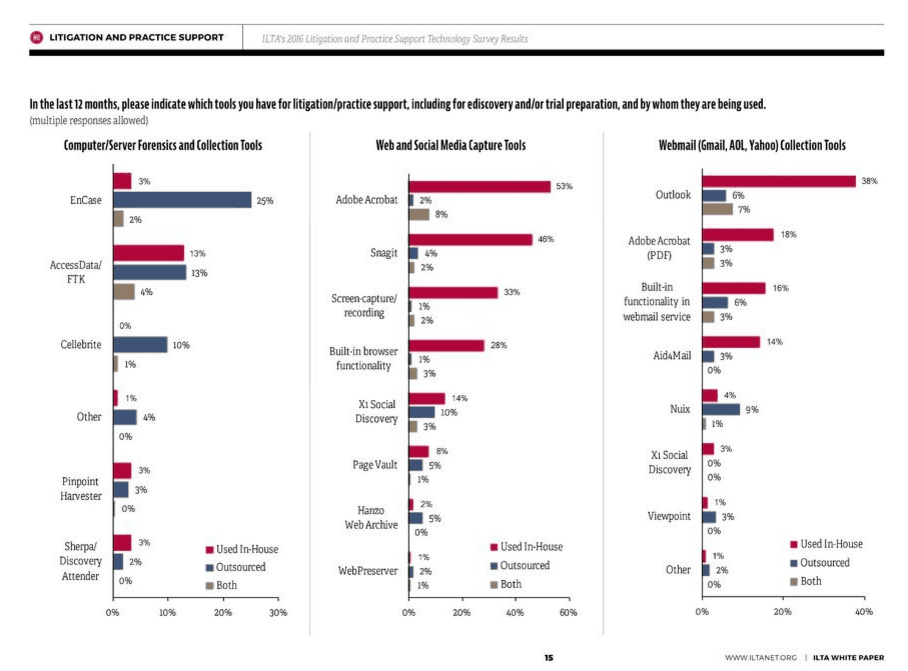The International Legal Technology Association recently published a very informative and comprehensive law firm eDiscovery practice survey “2016 Litigation and Practice Support Technology Survey.” ILTA received responses from 204 different law firms — small, medium and large — on a variety of subjects, including eDiscovery practice trends and software tool usage. The survey reveals three key takeaways regarding social media and website discovery.
The first clear takeaway is that social media discovery is clearly increasing among law firms and in the field in general. 77 percent of responding law firms reported conducting social media discovery in 2016, a 12 percent increase over 2015. Additionally, the responding firms reported a higher average volume of cases involving social media evidence, with a 23 percent increase in firms handling at least 4 matters per year involving social media evidence. (See Survey at pg. 23)
In terms of identified software solution usage, the survey establishes that X1 Social Discovery is the clear leader in the web and social media capture category among purpose-built tools used by law firms. 24 percent of all law firms rely on X1 Social Discovery on either an in-sourced or outsourced basis. The survey also reflects that X1 Social is the number one process used by eDiscovery service providers, by far surpassing the next common process of screen capturing. This is consistent with our own internal data, reflecting the industry’s standardization of social media evidence collection by the sheer volume of customers that have adopted X1 Social Discovery. Nearly 200 law firms and 500 eDiscovery services firms have at least one paid license of X1 Social Discovery. So while X1 Social Discovery is very popular with law firms, it is even more widely used by eDiscovery service providers.
Utilization of X1 Social also registered in the separate category of webmail collections.
The final takeaway is that the practice of using screen captures with general IT tools like Adobe and Snagit is still commonly employed by practitioners at law firms, but is virtually non-existent amongst service providers, who typically are on the forefront of adapting best practices. Screen capturing is neither effective nor defensible. It is ineffective because the results are very narrow and incomplete, and the process is very labor intensive resulting in much higher costs to the client than using best practices. (See Stallings v. City of Johnston, 2014 WL 2061669 (S.D. Ill. May 19, 2014), law firm spent full week screen capturing contents of Facebook account — which amounted to over 500 printed pages — manually rearranging them, and then redacting at a cost of tens of thousands of dollars).
In addition, simple screen captures are not defensible, with several courts disallowing or otherwise calling into question social media evidence presented in the form of a screen shot image. This scrutiny will only increase with Federal Rule of Evidence 902(14) coming into effect later this year. I have previously addressed Rule 902(14) at length on this blog, but in a nutshell, screen captures are not Rule 902(14) compliant, while best practices technology like X1 Social Discovery have the critical ability to collect all available metadata and generate a MD5 checksum, or “hash value,” of the preserved data for verification of the integrity of the evidence. The generation of hash values is a key component for meeting the requirements of FRE 902(14).
The ILTA Litigation Practice survey results can be accessed here. For more information about how to conduct effective social medial investigations, please contact us, or request a free demo version of X1 Social Discovery.

